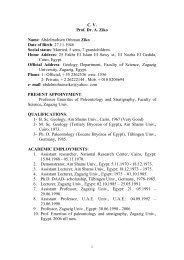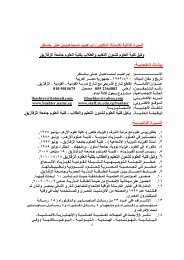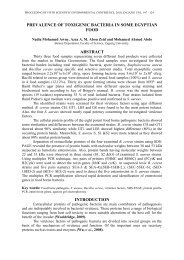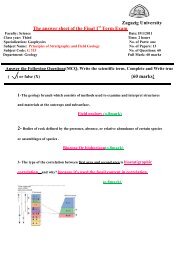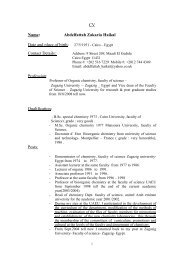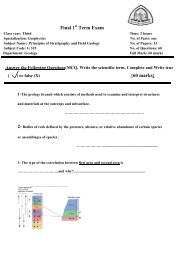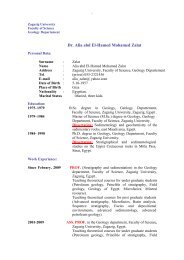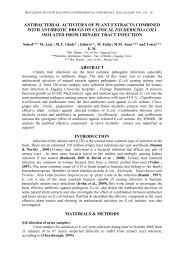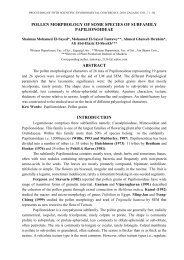flood hazard betwee marsa alam - ras ba as, red sea, egypt abstract ...
flood hazard betwee marsa alam - ras ba as, red sea, egypt abstract ...
flood hazard betwee marsa alam - ras ba as, red sea, egypt abstract ...
You also want an ePaper? Increase the reach of your titles
YUMPU automatically turns print PDFs into web optimized ePapers that Google loves.
18M. A. AzabBaker and Pickup (1987), Cunnane (1987), Klemes (1987), T<strong>as</strong>ker (1987), Patton (1988) andSummerfield (1991). Moreover, studies in fluvial geomorphology and morphometry of some<strong>flood</strong> vulnerable are<strong>as</strong> of Egypt such <strong>as</strong> Sinai and the E<strong>as</strong>tern Desert and have receivedparticulars consideration by some workers (e.g. Mo<strong>ba</strong>rek et al. 1981; EI K<strong>as</strong>s<strong>as</strong> and ElRakaiby 1983; Salem 1985; El Shamy 1985, Schick and Lekach 1987; Saleh 1989 a, b, c; ElRakaiby 1989; EI Etr and Ashmawy 1993; Ashmawy 1993; Yahia et al. 1999 a, b; EI-Etr etal. 1999; Ashmawy et al. 2000; Ashmawy 2001,2002 and Kamh 2002).The study area is located in the central E<strong>as</strong>tern Desert of Egypt and lies entirely within thecatchment area of the Red Sea. It is bounded from the e<strong>as</strong>t by the Red Sea and from the westby the River Nile-Red Sea water divide, and is limited by maximum latitudes 24° and 25° N(Fig. 1). It is of elongated and covers an area of about 6000 km2.Geomorphological studies may give information about the are<strong>as</strong> affected by <strong>flood</strong>ing.Studying the morphometric parameters of drainage <strong>ba</strong>sins is very important for determinationof the intensity of <strong>flood</strong>s, and provides suitable solutions for avoiding or <strong>red</strong>ucing <strong>as</strong> much <strong>as</strong>possible, <strong>hazard</strong>s that occur, in addition to incre<strong>as</strong>ing groundwater recharge. The study of thehydro-geochemical characters of groundwater in Wadi EI-Gemal <strong>ba</strong>sin (at the middle part ofthe study area) is important for domestic, livestock and irrigation uses. Beside deciphering thedifferent landforms and the drainage courses and their <strong>ba</strong>sins, this study helps to define thelocations and distribution of the Plio-Quaternary fans of pro<strong>ba</strong>bly great importance to thegroundwater recharge.Methods Of StudyQualitative and quantitative geomorphic analyses of the drainage <strong>ba</strong>sins in the area <strong>betwee</strong>nMarsa Alam and R<strong>as</strong> Ban<strong>as</strong> were me<strong>as</strong>u<strong>red</strong> and analyzed for fl<strong>as</strong>h <strong>flood</strong> (Fig. 1).These parameters give a better understanding for surface water potentialities in the definedhydrographic <strong>ba</strong>sins. Drainage networks of each drainage <strong>ba</strong>sin were delineated from photomosaic(1 :50,000), topographic maps (24 maps at scale 1 :50,000) and landsat images ofscale 1:50.000, <strong>as</strong> well <strong>as</strong>, field observations. Twenty-three drainage <strong>ba</strong>sins were defined andmapped.The geomorphological parameters of each <strong>ba</strong>sin were defined in terms of stream order,bifurcation ratio (Horton 1945 and Strahler 1952), <strong>ba</strong>sin shape (Miller 1953 and Schumm1956), sinuosity (Mueller 1968), relief ratio (Schumm 1956.) and ruggedness number (Melton1957). The rainfall and surface runoff were defined according to the equation given by Ball(1937).Topography And GeomorphologyThe study area comprises essentially high and rugged mountains, built up of a seriesmountain our range, more or less coherently trending parallel to the co<strong>as</strong>t and interrupted by anumber of detached m<strong>as</strong>ses and peaks (Fig. 2). The high peaks are concentrated in thesouthwestern corner where they rise to elevations up to 1975m (Ga<strong>ba</strong>1 Hamata). The RiverNile-Red Sea water divide runs over the high peaks of the Red Sea Mountains with anaverage elevation of 650m. A large number of wadis initiate from the mountainous terraindissecting the area and run toward the Red Sea following the general e<strong>as</strong>tward slope. They aremostly oriented E-W, WNW-ENE, NNW-SSE and NE-NW. The main wadis are veryimportant sutable are<strong>as</strong> for extending net of roads crossing the area and <strong>as</strong> the main arteriesfor groundwater. Slope gradient is mostly steep in the upper reaches of drainageways andtends to be gentle to the e<strong>as</strong>t.



